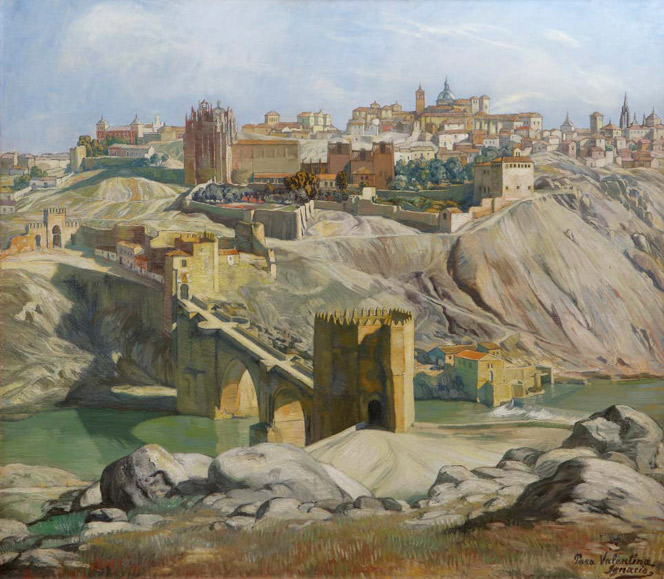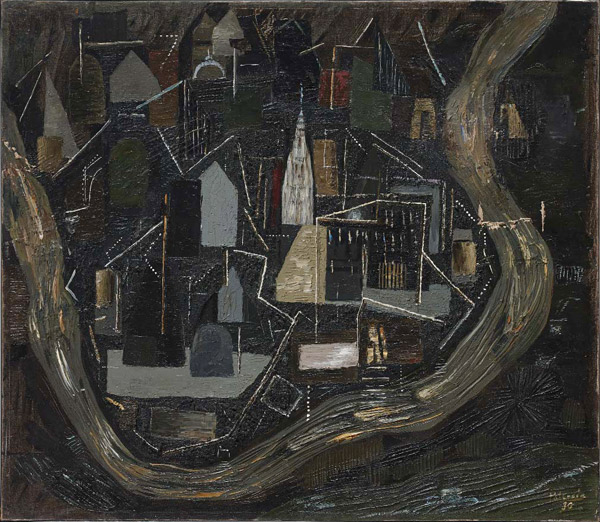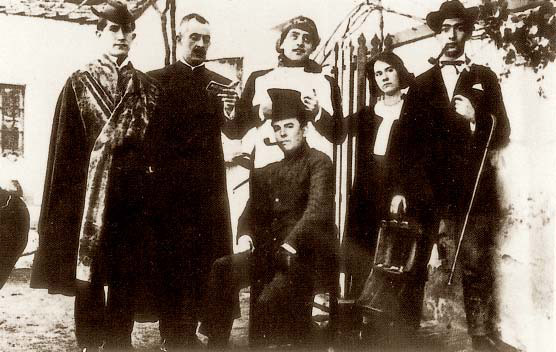

«Toledo is a city that offers the most characteristic image of the most genuine Spanish land and civilization. For this reason, any traveller in possession of time while in Spain should spend it, without hesitation, going to ».
«Witness Toledo, and in Toledo, El Greco».
Manuel B. Cossío
 Ignacio Zuloaga, Paisaje claro de Toledo, 1932. Óleo sobre lienzo. Museo Ignacio Zuloaga, Castillo de Pedraza.
Ignacio Zuloaga, Paisaje claro de Toledo, 1932. Óleo sobre lienzo. Museo Ignacio Zuloaga, Castillo de Pedraza.
 Benjamín Palencia, Toledo de noche, 1930. Óleo sobre lienzo. Museo Nacional Centro de Arte Reina Sofía, Madrid.
Benjamín Palencia, Toledo de noche, 1930. Óleo sobre lienzo. Museo Nacional Centro de Arte Reina Sofía, Madrid.
Due to its historic and artistic importance and the value of its monuments, the city of Toledo became a focal point to every ideological, spiritual and aesthetic search made by an entire pleiad of Spanish and foreign intellectuals and artists. All these led to the creation of an image that depicts the city as a referential place for the Spanish Liberalism.
Manuel B. Cossío declared that he was able to learn how to “witness Toledo, and in Toledo, El Greco” thanks to Juan Facundo Riaño and José Fernández Jiménez, who were both friends of Giner from University (Granada).
From that moment on, Toledo became the «city that offers the most characteristic image of the most genuine Spanish land and civilization […] the most brilliant, suggestive and accurate summary about the history of our homeland».
Furthermore, the ILE included it as its main destination in the excursion programme from the very beginning (1879), which made of the city bathed by the Tajo river a pilgrimage site, whose only competitor was the Sierra de Guadarrama.
Toledo and its landscapes became a recurrent element in the compositions of several artists, such as Carlos de Haes, Aureliano de Beruete, Joaquín Sorolla, Cecilio Pizarro (who was born in Toledo) or Ricardo Arredondo. Toledo is, in fact, really common in the paintings made by Spanish and foreign authors working in between both centuries, period in which El Greco was rediscovered, attracting thus the most distinguished artists.
This symbolic and patrimonial value acquisition process experienced by Toledo (and El Greco) started with the European travellers of the XIX Century and their romantic and picturesque taste; they visited the city attracted by its geography, its monuments, and its historical singularity. The last artistic contributions in which Toledo had an important role were made by intellectuals, writers and artists in the Spanish Silver Age.
Artists like Azorín, Baroja, Galdós, Pardo Bazán contributed with their prose, just like Rilke did with his poetry or Ignacio Zuloaga with his pictures, in the creation of the archetype of the city. The trips to Toledo became somehow an initiation rite to the regenerating generation of this turn of century.
«We are all artists; we all have the responsibility,
to awaken our activity and also to redirect its
laws when making and creating in any sphere of life».
Manuel B. Cossío
The socialist politic Julián Besteiro, who was a student at the ILE and also Cossío’s close friend, was strongly connected to Toledo. He was a professor in its High School and councillor at its Town Hall; he even met the woman whom he will marry, Dolores Cebrián (teacher at the Escuela Normal de Maestras de Toledo).
 Reunión de la Orden de Toledo en la Venta de Aires, Toledo, 1924. De izquierda a derecha, en la fotografía superior (realizada por Juan Vicéns), José Bello, José Moreno Villa, Luis Buñuel, José María Hinojosa (sentado), María Luisa González y Salvador Dalí; en la imagen inferior, José Bello, José Moreno Villa, María Luisa González, Luis Buñuel, Salvador Dalí y José María Hinojosa. Residencia de Estudiantes, Madrid.
Reunión de la Orden de Toledo en la Venta de Aires, Toledo, 1924. De izquierda a derecha, en la fotografía superior (realizada por Juan Vicéns), José Bello, José Moreno Villa, Luis Buñuel, José María Hinojosa (sentado), María Luisa González y Salvador Dalí; en la imagen inferior, José Bello, José Moreno Villa, María Luisa González, Luis Buñuel, Salvador Dalí y José María Hinojosa. Residencia de Estudiantes, Madrid.
The members of the Orden de Toledo, which included some of the intellectuals belonging to the Generation of '27 linked with the Residencia de Estudiantes, absorbed all this intellectual tradition, remodelling and reflecting it in their creations.
The doctor, scientific and liberal intellectual Gregorio Marañón is also highly connected to the city. This connection was reinforced by his purchase of the Cigarral de Menores. The narration of his book Elogio y nostalgia de Toledo (1941) is set in this city, which works as the background to the description of the history of Liberalism in Spain from his own point of view. His other work, El Greco y Toledo (1956) is a perfect example of the subtle introduction of geographical descriptions of the city, masterfully achieved through the narration of the life of El Greco. In this book, Marañón makes reference to Cossío’s monography on El Greco: «it has become a classic, not only for its serenity or its chronology, but for its permanent brilliant efficiency».